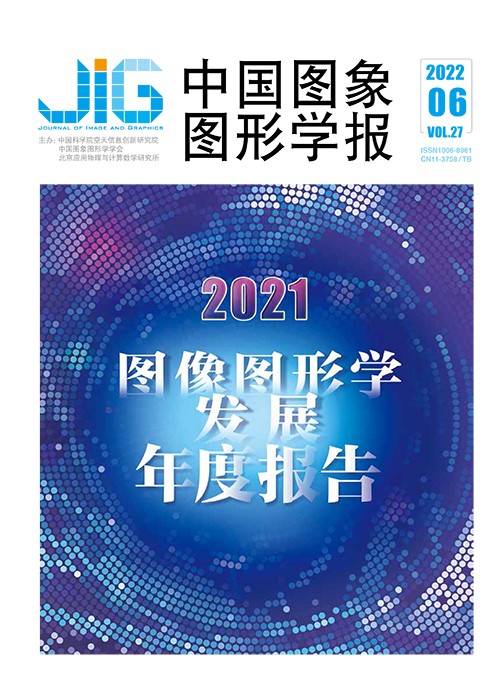
基于深度学习的视觉目标检测技术综述
曹家乐1, 李亚利2, 孙汉卿1, 谢今3, 黄凯奇4, 庞彦伟1(1.天津大学, 天津 300072;2.清华大学, 北京 100084;3.重庆大学, 重庆 400044;4.中国科学院自动化研究所, 北京 100190) 摘 要
视觉目标检测旨在定位和识别图像中存在的物体,属于计算机视觉领域的经典任务之一,也是许多计算机视觉任务的前提与基础,在自动驾驶、视频监控等领域具有重要的应用价值,受到研究人员的广泛关注。随着深度学习技术的飞速发展,目标检测取得了巨大的进展。首先,本文总结了深度目标检测在训练和测试过程中的基本流程。训练阶段包括数据预处理、检测网络、标签分配与损失函数计算等过程,测试阶段使用经过训练的检测器生成检测结果并对检测结果进行后处理。然后,回顾基于单目相机的视觉目标检测方法,主要包括基于锚点框的方法、无锚点框的方法和端到端预测的方法等。同时,总结了目标检测中一些常见的子模块设计方法。在基于单目相机的视觉目标检测方法之后,介绍了基于双目相机的视觉目标检测方法。在此基础上,分别对比了单目目标检测和双目目标检测的国内外研究进展情况,并展望了视觉目标检测技术发展趋势。通过总结和分析,希望能够为相关研究人员进行视觉目标检测相关研究提供参考。
关键词
A survey on deep learning based visual object detection
Cao Jiale1, Li Yali2, Sun Hanqing1, Xie Jin3, Huang Kaiqi4, Pang Yanwei1(1.Tianjin University, Tianjin 300072, China;2.Tsinghua University, Beijing 100084, China;3.Chongqing University, Chongqing 400044, China;4.Institute of Automation, Chinese Academy of Sciences, Beijing 100190, China) Abstract
Visual object detection aims to locate and recognize objects in images, which is one of the classical tasks in the field of computer vision and also the premise and foundation of many computer vision tasks. Visual object detection plays a very important role in the applications of automatic driving, video surveillance, which has attracted extensive attention of the researches in past few decades. In recent years, with the development of the technique of deep learning, visual object detection has also made great progress. This paper focuses on a deep survey on deep learning based visual object detection, including monocular object detection and stereo object detection. First, we summarize the pipeline of deep object detection during the training and inference. The training process is composed of data pre-processing, detection network design, and label assignment and loss function in common. Data pre-processing (e.g., multi-scale training and flip) aims to enhance the diversity of the given training data, which can improve detection performance of object detector. Detection network usually consists of three key parts like the backbone (e.g., Visual Geometry Group(VGG) and ResNet), feature fusion module (e.g., feature pyramid network(FPN)), and prediction network (e.g., region of interest head network(RoI head)). Label assignment aims to assign the true value for each prediction, and loss function can supervise the network training. During inference, we adopt the trained detector to generate the detection bounding-boxes and employ the post-processing step (e.g., non-maximum suppression(NMS)) to combine the bounding-boxes. Second, we illustrate a deep review on monocular object detection, including anchor-based, anchor-free, and end-to-end methods, respectively. Anchor-based methods design some default anchors and perform classification and regression based on these default anchors, which can be further split into two-stage and one-stage methods. Two-stage methods first generate some candidate proposals based on the default anchors, and second classify/regress these proposals. Compared to two-stage methods, one-stage methods directly perform classification and regression on default anchors directly, which usually have a faster inference speed. The representative two-stage methods are regional-based convolutional neural network (R-CNN) series, and the representative one-stage methods are you only look once (YOLO) and single shot detector (SSD). Compared to anchor-based methods, more robust anchor-free methods perform classification and regression without any hand-crafted default anchors. We split anchor-free methods into keypoint-based methods, and center-based methods. Keypoint-based methods predict multiple keypoints of objects for localization, while center-based methods predict the left, right, top, and bottom distances to the object boundary. The representative keypoint-based method is CornerNet, and the representative center-based methods are fully convolutional one-stage detector (FCOS) and CenterNet. The anchor-based methods and anchor-free methods mentioned above require the post-processing to remove the redundant detection results for each object in common. To solve this problem, the recently introduced end-to-end methods directly predict one bounding box for each object straightforward, which can avoid the post-processing. The representative end-to-end method is detection transformer (DETR) that performs prediction via a transformer module. In addition, we review some classical modules employed in monocular object detection, including feature pyramid structure, prediction network design, label assignment and loss function. The feature pyramid structure employs different layers to detect multi-scaled objects, which can deal with scale variance issue. Prediction network design contains the re-designs of classification and regression, which aims to better deal with these two sub-tasks. Label assignment and loss function aim to better guide detector training. Third, we introduce stereo object detection. According to the coordinate space of features, existing detectors are divided into two categories:frustum-based and inverse-projection-based approaches. Frustum-based approaches directly predict 3D objects on features in the image frustum space. Stereo R-CNN and StereoCenterNet construct stereo features in the image frustum space via concatenating a pair of unary features concatenation. Plane-sweeping is another method of constructing frustum features as cost volumes, which is used in instance-depth-aware 3D detection (IDA-3D) and YOLOStereo3D. In contrast to the frustum-based approaches, inverse-projection-based approaches explicitly project the pixels or frustum features into 3D Cartesian space. There are mainly three manners of the inverse projection:projecting all pixels to the full 3D space as a pseudo point cloud, projecting the cost volume features to 3D feature volume features, or projecting the pixels in each region proposal to an instance-level point cloud. Pseudo-LiDAR is a pioneer method that transforms stereo images to their point cloud representation, which embraces the advances in both disparity estimation and LiDAR-based 3D detection. Deep stereo geometry network (DSGN) projects the frustum-based cost volume features to 3D volume features and further squeezes them into bird's eye view (BEV) for detection. Disp R-CNN leverages Mask R-CNN, a representative 2D instance segmentation model, and generates a set of instance-level point clouds for each stereo image pair. Based on the summary of monocular and stereo object detection, we further compare the progress of domestic and foreign researches, and present some representative universities or companies on visual object detection. Finally, we present some development tendency in visual object detection, including efficient end-to-end object detection, self-supervised object detection, long-tailed object detection, few-shot and zero-shot object detection, large-scale stereo object detection dataset, weakly-supervised stereo object detection.
Keywords
|



 中国图象图形学报 │ 京ICP备05080539号-4 │ 本系统由
中国图象图形学报 │ 京ICP备05080539号-4 │ 本系统由